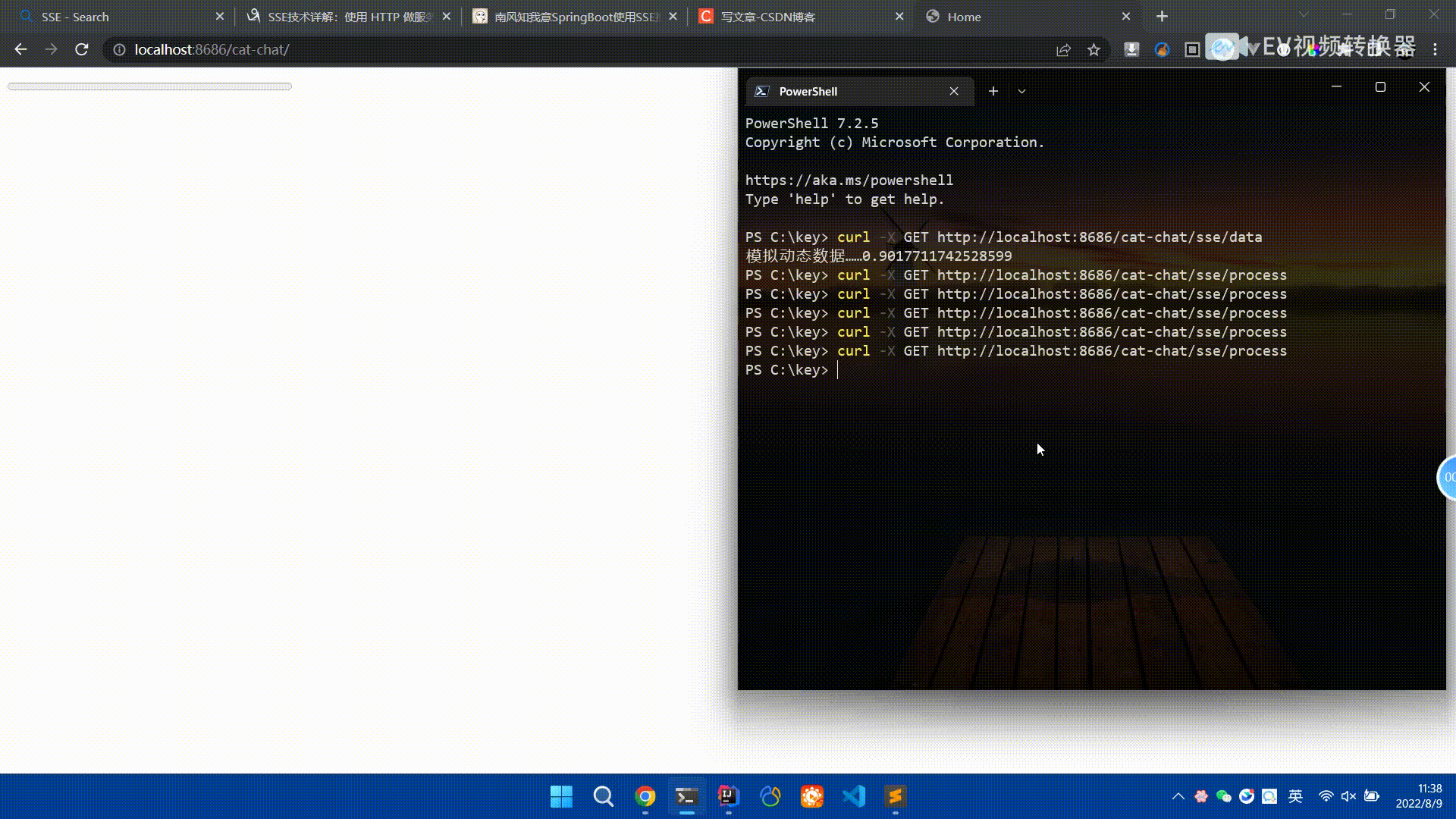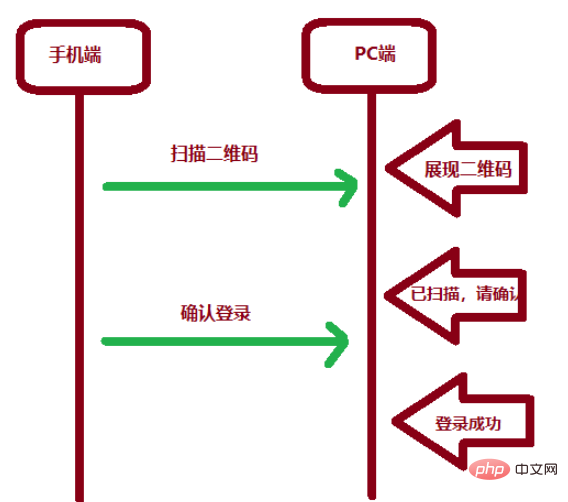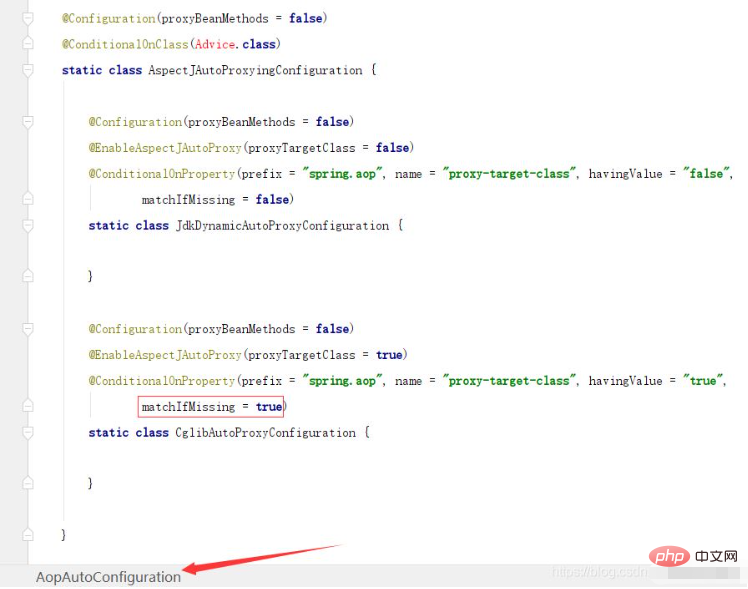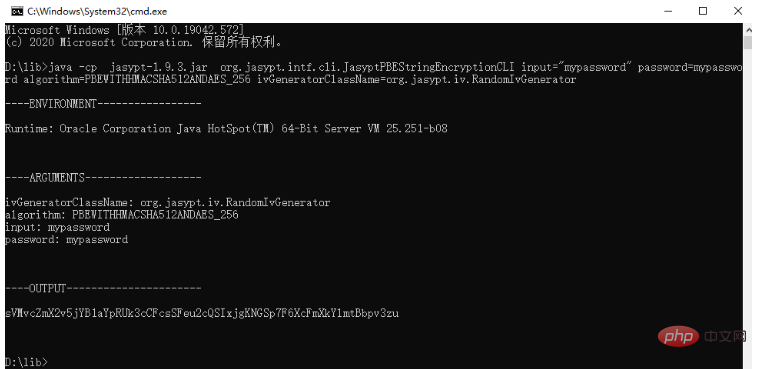OAuth3簡介
OAuth 是一個開放標準,該標準允許用戶讓第三方應用程式存取該用戶在某一網站上儲存的私密資源(如頭像、照片、影片等),而在這個過程中無須將使用者名稱和密碼提供給第三方應用程式。
存取儲存在特定服務提供者中的數據,採用的是使用令牌而非使用者名稱和密碼的方式實作。每一個令牌授權一個特定的網站在特定的時間段內存取特定的資源。
OAuth使用戶可以授權第三方網站靈活地存取儲存在另一些資源伺服器上的特定信息,而不是所有資訊。例如,使用者想透過QQ 登入知乎,這時知乎就是一個第三方應用,知乎要存取使用者的一些基本資訊就需要得到使用者的授權,如果使用者把自己的QQ 使用者名稱和密碼告訴知乎,那麼知乎就能存取使用者的所有數據,而且只有使用者修改密碼才能收回權限,這種授權方式安全隱患很大,如果使用OAuth ,就能很好的解決這一問題。
採用令牌的方式可以讓使用者靈活的對第三方應用授權或收回權限。 OAuth 2 是 OAuth 協定的下一版,不過與 OAuth 1.0 不具備向下相容性。
OAuth 2 專注於客戶端開發者的簡易型,同時為Web應用、桌面應用,行動裝置、客廳裝置提供專門的認證流程。傳統的Web 開發登入認證一般都是基於Session 的,但前後端分離的架構中繼續使用Session 會有許多不便,因為行動裝置(Android、IOS、微信小程式等)要不是不支援Cookie(微信小程式) ,要嘛使用非常不便,對於這些問題,使用OAuth 2 認證都能解決。
OAuth3角色
先了解OAuth 2 中幾個基本的角色
資源擁有者:即用戶,具有頭像、照片、影片等資源
客戶端:即第三方應用
#授權伺服器:用來驗證使用者提供的資訊是否正確,並傳回一個令牌給第三方應用
資源伺服器:提供給使用者資源的伺服器,例如頭像、照片、影片等資源
一般來說,授權伺服器和資源伺服器可以是同一台伺服器。
OAuth3授權流程
步驟01:客戶端(第三方應用程式)向使用者請求授權。
當使用者在服務授權頁面上按一下同意授權按鈕後,服務端會向用戶端傳回授權許可憑證。
步驟03:客戶端拿著授權許可證去授權伺服器申請令牌。
步驟04:授權伺服器驗證資訊無誤後,發放令牌給客戶端。
步驟05:客戶端拿著令牌去資源伺服器存取資源。
步驟06:資源伺服器驗證令牌無誤後開放資源。
授權模式
OAuth 協定的授權模式共分為4 種,如下
授權碼授權模式是授權方式中功能最齊全、流程最嚴謹的,其授權碼(authorization code)是關鍵。這種模式的特點在於客戶端的伺服器與授權伺服器進行交互,國內常見的第三方平台登入功能基本上都採用了這種方式
簡化模式:簡化模式不需要客戶端伺服器參與,直接在瀏覽器中向授權伺服器申請令牌,一般若是純靜態頁面,則可以採用這種方式
在密碼模式下,使用者直接向客戶端提供自己的使用者名稱和密碼,客戶端則使用這些資訊向授權伺服器請求存取權杖。使用者需要了解客戶端的高度訊息,例如客戶端應用程式和服務提供者是否同一家公司
#在客戶端模式下,服務提供者授權給客戶端而非特定使用者。嚴格來說,客戶端模式並不能算作OAuth 協定要解決的問題的一種解決方案,但是,對於開發者而言,在一些前後端分離應用或為行動端提供的認證授權伺服器上使用這種模式還是非常方便的
4 種模式各有千秋,分別適用於不同的開發場景,開發者根據實際情況進行選擇
實踐
此處介紹的是在前後端分離應用(或為行動端、微信小程式等)提供的認證伺服器中如何建構OAuth 服務,因此主要介紹密碼模式。
1. 建立專案新增依賴
建立Spring Boot Web 項目,新增以下依賴
<dependency>
<groupId>org.springframework.boot</groupId>
<artifactId>spring-boot-starter-web</artifactId>
</dependency>
<dependency>
<groupId>org.springframework.boot</groupId>
<artifactId>spring-boot-starter-data-redis</artifactId>
<exclusions>
<exclusion>
<groupId>io.lettuce</groupId>
<artifactId>lettuce-core</artifactId>
</exclusion>
</exclusions>
</dependency>
<dependency>
<groupId>redis.clients</groupId>
<artifactId>jedis</artifactId>
</dependency>
<dependency>
<groupId>org.springframework.boot</groupId>
<artifactId>spring-boot-starter-security</artifactId>
</dependency>
<dependency>
<groupId>org.springframework.security.oauth</groupId>
<artifactId>spring-security-oauth3</artifactId>
<version>2.3.3.RELEASE</version>
</dependency>由於Spring Boot 中的OAuth 協定是在Spring Security 的基礎上完成的,因此首先要添加Spring Security 依賴,要用到OAuth 2,因此添加OAuth 2 相關依賴,令牌可以存儲在Redis 緩存伺服器上,同時Redis 具有過期等功能,很適合令牌的存儲,因此也加入Redis依賴。
設定 application.properties
spring.redis.database=0
spring.redis.host=ip地址
spring.redis.port=6379
spring.redis.password=root
spring.redis.jedis.pool.max-active=8
spring.redis.jedis.pool.max-idle=8
spring.redis.jedis.pool.max-wait=-1ms
spring.redis.jedis.pool.min-idle=0
2. 配置授权服务器
授权服务器和资源服务器可以是同一台服务器,也可以是不同服务器,此处假设是同一台服务器,通过不同的配置分别开启授权服务器和资源服务器,首先是授权服务器:
@Configuration
@EnableAuthorizationServer
public class AuthorizationServerConfig extends AuthorizationServerConfigurerAdapter {
@Autowired
AuthenticationManager authenticationManager;
@Autowired
RedisConnectionFactory redisConnectionFactory;
@Autowired
UserDetailsService userDetailsService;
@Bean
PasswordEncoder passwordEncoder() {
return new BCryptPasswordEncoder();
}
@Override
public void configure(ClientDetailsServiceConfigurer clients) throws Exception {
clients.inMemory()
.withClient("password")
.authorizedGrantTypes("password", "refresh_token")
.accessTokenValiditySeconds(1800)
.resourceIds("rid")
.scopes("all")
.secret("$2a$10$RMuFXGQ5AtH4wOvkUqyvuecpqUSeoxZYqilXzbz50dceRsga.WYiq");
}
@Override
public void configure(AuthorizationServerEndpointsConfigurer endpoints) throws Exception {
endpoints.tokenStore(new RedisTokenStore(redisConnectionFactory))
.authenticationManager(authenticationManager)
.userDetailsService(userDetailsService);
}
@Override
public void configure(AuthorizationServerSecurityConfigurer security) throws Exception {
security.allowFormAuthenticationForClients();
}
}代码解释:
自定义类继承自 AuthorizationServerConfigurerAdapter ,完成对授权服务器的配置,然后通过 @EnableAuthorizationServer 注解开启授权服务器
注入 AuthenticationManager 用来支持 password 模式
注入 RedisConnectionFactory 用来完成 Redis 缓存,将令牌信息储存到 Redis 缓存中
注入 UserDetailsService 该对象为刷新 token 提供支持
在 configure(ClientDetailsServiceConfigurer clients) 方法中配置 password 授权模式,authorizedGrantTypes 表示 OAuth 2 中的授权模式为 password 和 refresh_token 两种,在标准的 OAuth 2 协议中,授权模式并不包括 refresh_token ,但是在 Spring Security 的实现中将其归为一种,因此如果要实现 access_token 的刷新,就需要添加这样一种授权模式;accessTokenValiditySeconds 方法配置了 access_token 的过期时间;resourceIds 配置了资源 id;secret 方法配置了加密后的密码,明文是 123
configure(AuthorizationServerEndpointsConfigurer endpoints) 方法配置了令牌的存储,AuthenticationManager 和 UserDetailsService 主要用于支持 password 模式以及令牌的刷新
configure(AuthorizationServerSecurityConfigurer security) 方法配置表示支持 client_id 和 client_secret 做登录认证
3. 配置资源服务器
@Configuration
@EnableResourceServer
public class ResourceServerConfig extends ResourceServerConfigurerAdapter {
@Override
public void configure(ResourceServerSecurityConfigurer resources) throws Exception {
resources.resourceId("rid").stateless(true);
}
@Override
public void configure(HttpSecurity http) throws Exception {
http.authorizeRequests()
.antMatchers("/admin/**").hasRole("admin")
.antMatchers("/user/**").hasRole("user")
.anyRequest().authenticated();
}
}代码解释:
自定义类继承自 ResourceServerConfigurerAdapter ,并添加 @EnableResourceServer 注解开启资源服务器配置
resources.resourceId(“rid”).stateless(true); 配置资源 id,这里的资源 id 和授权服务器中的资源 id 一直,然后设置这些资源仅基于令牌认证
configure(HttpSecurity http) 方法配置 HttpSecurity
4. 配置 Security
@Configuration
public class WebSecurityConfig extends WebSecurityConfigurerAdapter {
@Bean
@Override
public AuthenticationManager authenticationManagerBean() throws Exception {
return super.authenticationManagerBean();
}
@Bean
@Override
protected UserDetailsService userDetailsService() {
return super.userDetailsService();
}
@Override
protected void configure(AuthenticationManagerBuilder auth) throws Exception {
auth.inMemoryAuthentication()
.withUser("admin")
.password("$2a$10$RMuFXGQ5AtH4wOvkUqyvuecpqUSeoxZYqilXzbz50dceRsga.WYiq")
.roles("admin")
.and()
.withUser("sang")
.password("$2a$10$RMuFXGQ5AtH4wOvkUqyvuecpqUSeoxZYqilXzbz50dceRsga.WYiq")
.roles("user");
}
@Override
protected void configure(HttpSecurity http) throws Exception {
http.antMatcher("/oauth/**").authorizeRequests()
.antMatchers("/oauth/**").permitAll()
.and().csrf().disable();
}
}这里两个 Bean 将注入授权服务器配置类中使用,另外,这里的 HttpSecurity 配置主要是配置 /oauth/** 模式的 URL ,这一类的请求直接放行。在 Spring Security 配置和资源服务器配置中,一共涉及两个 HttpSecurity ,其中 Spring Security 中的配置优先级高于资源服务器中的配置,即请求地址先经过 Spring Security 的 HttpSecurity ,再经过资源服务器的 HttpSecurity。
5. 验证测试
首先创建三个简单的请求地址
@RestController
public class HelloController {
@GetMapping("/admin/hello")
public String admin() {
return "Hello admin!";
}
@GetMapping("/user/hello")
public String user() {
return "Hello user!";
}
@GetMapping("/hello")
public String hello() {
return "hello";
}
}根据前文的配置,要请求这三个地址,分别需要 admin 角色、user 角色以及登录后访问。
所有都配置完成后,启动 Redis 服务器,再启动 Spring Boot 项目,首先发送一个 POST 请求获取 token,请求地址如下(注意这里是一个 POST 请求,为了显示方便,将参数写在地址栏中):http://localhost:8080/oauth/token?username=sang&password=123&grant_type=password&client_id=password&scope=all&client_secret=123
请求地址中包含的参数有用户名、密码、授权模式、客户端 id 、scope 以及客户端密码,基本就是授权服务器中所配置的数据,请求结果如图

其中 access_token 是获取其它资源时要用的令牌,refresh_token 用来刷新令牌,expires_in 表示 access_token 过期时间,当 access_token 过期后,使用 refresh_token 重新获取新的 access_token (前提是 refresh_token 未过期),请求地址(注意也是POST请求):http://localhost:8080/oauth/token?grant_type=refresh_token&refresh_token=693b0e36-4515-442a-8c5d-90bade3c74d2&client_id=password&client_secret=123
获取新的 access_token 时需要携带上 refresh_token ,同事授权模式设置为 refresh_token ,在获取的结果中 access_token 会变化,同时 access_token 有效期也会变化,如图

接下来访问所有资源,携带上 access_token 参数即可,例如 /user/hello 接口:http://localhost:8080/user/hello?access_token=0497e4bc-df37-460e-8755-b813b9dbf36a,访问结果如图

如果非法存取一個資源,例如sang 使用者存取/admin/hello 接口,結果如圖

到此,一個password 模式的OAuth 認證體係就搭建成功了。
OAuth 中的認證模式有4 中,開發者需要結合自己開發的實際情況來選擇其中一種,此處介紹的是在前後端分離應用中常用的password 模式,其它的授權模式也都有自己的使用場景。
整體來講,Spring Security OAuth 2 的使用還是較複雜的,配置也比較繁瑣,如果開發者的應用場景比較簡單,完全可以按照此處介紹的授權流程自己構建OAuth 2 認證體系。
以上是SpringBoot安全管理之OAuth2框架怎麼使用的詳細內容。更多資訊請關注PHP中文網其他相關文章!
 怎么使用SpringBoot+Canal实现数据库实时监控May 10, 2023 pm 06:25 PM
怎么使用SpringBoot+Canal实现数据库实时监控May 10, 2023 pm 06:25 PMCanal工作原理Canal模拟MySQLslave的交互协议,伪装自己为MySQLslave,向MySQLmaster发送dump协议MySQLmaster收到dump请求,开始推送binarylog给slave(也就是Canal)Canal解析binarylog对象(原始为byte流)MySQL打开binlog模式在MySQL配置文件my.cnf设置如下信息:[mysqld]#打开binloglog-bin=mysql-bin#选择ROW(行)模式binlog-format=ROW#配置My
 Spring Boot怎么使用SSE方式向前端推送数据May 10, 2023 pm 05:31 PM
Spring Boot怎么使用SSE方式向前端推送数据May 10, 2023 pm 05:31 PM前言SSE简单的来说就是服务器主动向前端推送数据的一种技术,它是单向的,也就是说前端是不能向服务器发送数据的。SSE适用于消息推送,监控等只需要服务器推送数据的场景中,下面是使用SpringBoot来实现一个简单的模拟向前端推动进度数据,前端页面接受后展示进度条。服务端在SpringBoot中使用时需要注意,最好使用SpringWeb提供的SseEmitter这个类来进行操作,我在刚开始时使用网上说的将Content-Type设置为text-stream这种方式发现每次前端每次都会重新创建接。最
 SpringBoot怎么实现二维码扫码登录May 10, 2023 pm 08:25 PM
SpringBoot怎么实现二维码扫码登录May 10, 2023 pm 08:25 PM一、手机扫二维码登录的原理二维码扫码登录是一种基于OAuth3.0协议的授权登录方式。在这种方式下,应用程序不需要获取用户的用户名和密码,只需要获取用户的授权即可。二维码扫码登录主要有以下几个步骤:应用程序生成一个二维码,并将该二维码展示给用户。用户使用扫码工具扫描该二维码,并在授权页面中授权。用户授权后,应用程序会获取一个授权码。应用程序使用该授权码向授权服务器请求访问令牌。授权服务器返回一个访问令牌给应用程序。应用程序使用该访问令牌访问资源服务器。通过以上步骤,二维码扫码登录可以实现用户的快
 SpringBoot/Spring AOP默认动态代理方式是什么May 10, 2023 pm 03:52 PM
SpringBoot/Spring AOP默认动态代理方式是什么May 10, 2023 pm 03:52 PM1.springboot2.x及以上版本在SpringBoot2.xAOP中会默认使用Cglib来实现,但是Spring5中默认还是使用jdk动态代理。SpringAOP默认使用JDK动态代理,如果对象没有实现接口,则使用CGLIB代理。当然,也可以强制使用CGLIB代理。在SpringBoot中,通过AopAutoConfiguration来自动装配AOP.2.Springboot1.xSpringboot1.xAOP默认还是使用JDK动态代理的3.SpringBoot2.x为何默认使用Cgl
 spring boot怎么对敏感信息进行加解密May 10, 2023 pm 02:46 PM
spring boot怎么对敏感信息进行加解密May 10, 2023 pm 02:46 PM我们使用jasypt最新版本对敏感信息进行加解密。1.在项目pom文件中加入如下依赖:com.github.ulisesbocchiojasypt-spring-boot-starter3.0.32.创建加解密公用类:packagecom.myproject.common.utils;importorg.jasypt.encryption.pbe.PooledPBEStringEncryptor;importorg.jasypt.encryption.pbe.config.SimpleStrin
 使用Java SpringBoot集成POI实现Word文档导出Apr 21, 2023 pm 12:19 PM
使用Java SpringBoot集成POI实现Word文档导出Apr 21, 2023 pm 12:19 PM知识准备需要理解ApachePOI遵循的标准(OfficeOpenXML(OOXML)标准和微软的OLE2复合文档格式(OLE2)),这将对应着API的依赖包。什么是POIApachePOI是用Java编写的免费开源的跨平台的JavaAPI,ApachePOI提供API给Java程序对MicrosoftOffice格式档案读和写的功能。POI为“PoorObfuscationImplementation”的首字母缩写,意为“简洁版的模糊实现”。ApachePOI是创建和维护操作各种符合Offic
 springboot怎么配置mybatis和事务管理May 10, 2023 pm 07:13 PM
springboot怎么配置mybatis和事务管理May 10, 2023 pm 07:13 PM一、springboot与mybatis的配置1.首先,springboot配置mybatis需要的全部依赖如下:org.springframework.bootspring-boot-starter-parent1.5.1.RELEASEorg.springframework.bootspring-boot-starter-web1.5.1.RELEASEorg.mybatis.spring.bootmybatis-spring-boot-starter1.2.0com.oracleojdbc
 springboot怎么整合shiro实现多验证登录功能May 10, 2023 pm 04:19 PM
springboot怎么整合shiro实现多验证登录功能May 10, 2023 pm 04:19 PM1.首先新建一个shiroConfigshiro的配置类,代码如下:@ConfigurationpublicclassSpringShiroConfig{/***@paramrealms这儿使用接口集合是为了实现多验证登录时使用的*@return*/@BeanpublicSecurityManagersecurityManager(Collectionrealms){DefaultWebSecurityManagersManager=newDefaultWebSecurityManager();


熱AI工具

Undresser.AI Undress
人工智慧驅動的應用程序,用於創建逼真的裸體照片

AI Clothes Remover
用於從照片中去除衣服的線上人工智慧工具。

Undress AI Tool
免費脫衣圖片

Clothoff.io
AI脫衣器

AI Hentai Generator
免費產生 AI 無盡。

熱門文章

熱工具

VSCode Windows 64位元 下載
微軟推出的免費、功能強大的一款IDE編輯器

MantisBT
Mantis是一個易於部署的基於Web的缺陷追蹤工具,用於幫助產品缺陷追蹤。它需要PHP、MySQL和一個Web伺服器。請查看我們的演示和託管服務。

mPDF
mPDF是一個PHP庫,可以從UTF-8編碼的HTML產生PDF檔案。原作者Ian Back編寫mPDF以從他的網站上「即時」輸出PDF文件,並處理不同的語言。與原始腳本如HTML2FPDF相比,它的速度較慢,並且在使用Unicode字體時產生的檔案較大,但支援CSS樣式等,並進行了大量增強。支援幾乎所有語言,包括RTL(阿拉伯語和希伯來語)和CJK(中日韓)。支援嵌套的區塊級元素(如P、DIV),

Dreamweaver CS6
視覺化網頁開發工具

SublimeText3 Mac版
神級程式碼編輯軟體(SublimeText3)






